Constance Ore is a retired Teacher, Choir Director, and Organist. And a formidable cook.
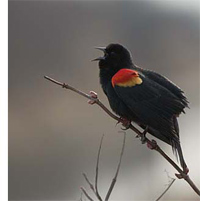 The grand sounds of spring came to Sanctuary yesterday. There were meadow larks at dawn, and chains of wild geese flying overhead all morning calling out instructions to each other as they passed. In the afternoon, the red winged blackbirds came back to claim their territories from the tree tops while the cardinals have already been very actively singing out their spaces for several days now. I read that birds can share trees with other species because they live at different levels, but they must let others of their kind know what is theirs, hence all that marvelous song. The grand sounds of spring came to Sanctuary yesterday. There were meadow larks at dawn, and chains of wild geese flying overhead all morning calling out instructions to each other as they passed. In the afternoon, the red winged blackbirds came back to claim their territories from the tree tops while the cardinals have already been very actively singing out their spaces for several days now. I read that birds can share trees with other species because they live at different levels, but they must let others of their kind know what is theirs, hence all that marvelous song.
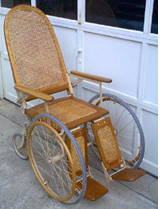 Today, as we cross the meadow on a walk, I am leaning heavily on Charles’ arm and we are moving very slowly. “What a life!” I say sadly. “Yes” he says firmly, “and it IS a life. . . with options, including long-range ones”. After a bit, I say, “I would suppose that they have wheel-chairs in Russia” and he immediately replies, “Of course they do. . . at the very least, those big wooden ones with the high backs.” We are both smiling as we conjure up our own mental pictures of the possibilities. Today, as we cross the meadow on a walk, I am leaning heavily on Charles’ arm and we are moving very slowly. “What a life!” I say sadly. “Yes” he says firmly, “and it IS a life. . . with options, including long-range ones”. After a bit, I say, “I would suppose that they have wheel-chairs in Russia” and he immediately replies, “Of course they do. . . at the very least, those big wooden ones with the high backs.” We are both smiling as we conjure up our own mental pictures of the possibilities.
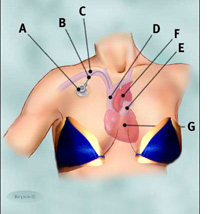 A Port A Port
B Catheter [tubing]
C Subclavian vein
D Superior Vena cava
E Pulmonary vein
F Aorta
G Heart
Today is the last of ten injections of Neupogen, and for three splendid days, I will not have any needles. When the nurse from the Med Center called, she asked, “Do you have a port?” and blessedly, before I could reply, “No, we live in the country” she went on, “or do they stick you every time they draw the blood?” I told her that so far, no port. This led me to ask about ports, and I found out that there are several types, but the one preferred for me might be the surgically implanted Subcutaneous (under the skin) catheter. One end of the catheter is fed into a large vein leading directly into the heart. The other end is attached to a small chamber called a portal. The portal is made of either metal or plastic with a rubber top that seals it and is placed under the skin. When blood is drawn through this, a special needle that has a tube attached to it is entered through the portal, and the job is taken care of that way.
Apparently, after a while the skin over the port becomes very tough and insensitive and one doesn’t feel anything.
 That led me to consider the possibilities of “ports”. One can easily imagine lots of the little things discreetly placed on the body; one to house the tiny iPod, perhaps, one for a cell phone, or little fingertip cameras. Just think of the convenience! That led me to consider the possibilities of “ports”. One can easily imagine lots of the little things discreetly placed on the body; one to house the tiny iPod, perhaps, one for a cell phone, or little fingertip cameras. Just think of the convenience!
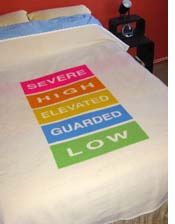 As these days pass from winter into spring, I think about thoughts and prayers and their power and presence in my life. My latest way of attempting to visualize this is as great threading of thought that makes up the security blanket that wraps me round. In spite of the incredible ups and downs of spirit and physical being, at the end of the day I feel calm and hopeful, able to count and see the incredible blessings that are mine – a loving and caring God, Charles, children, friends, doctors and medicines and therapies – on and on. . . even Alphie, with his need to run through the woods insuring my exercise and connection to the beautiful place of my abode. As these days pass from winter into spring, I think about thoughts and prayers and their power and presence in my life. My latest way of attempting to visualize this is as great threading of thought that makes up the security blanket that wraps me round. In spite of the incredible ups and downs of spirit and physical being, at the end of the day I feel calm and hopeful, able to count and see the incredible blessings that are mine – a loving and caring God, Charles, children, friends, doctors and medicines and therapies – on and on. . . even Alphie, with his need to run through the woods insuring my exercise and connection to the beautiful place of my abode.
 March 1, Ash Wednesday, marked the 75th day anniversary of sitting at the table and feeling the great unease and depression as I was sending out Christmas cards. It was the beginning of my new life. This is both a long time and a short one, depending on the measure. . . not quite the “90 days in jail” which used to be the norm for punishing all kinds of misadventures in the days of my youth in Iowa, but far too long for a visit by even the most beloved relative. March 1, Ash Wednesday, marked the 75th day anniversary of sitting at the table and feeling the great unease and depression as I was sending out Christmas cards. It was the beginning of my new life. This is both a long time and a short one, depending on the measure. . . not quite the “90 days in jail” which used to be the norm for punishing all kinds of misadventures in the days of my youth in Iowa, but far too long for a visit by even the most beloved relative.
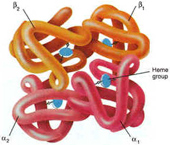 The blood draw yesterday again indicated that the disease remains active. It has taken a while for me not to regard this weekly check as sort of a test, where surely, improvement would be shown. It is the teacher brain, I think. . . try hard, do your best, and you will do better next time. Harder even than the reality of no immune system is the life of the low hemoglobin count, where the absence of red blood cells to haul oxygen around means that one is always, always weary. The blood draw yesterday again indicated that the disease remains active. It has taken a while for me not to regard this weekly check as sort of a test, where surely, improvement would be shown. It is the teacher brain, I think. . . try hard, do your best, and you will do better next time. Harder even than the reality of no immune system is the life of the low hemoglobin count, where the absence of red blood cells to haul oxygen around means that one is always, always weary.
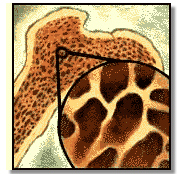 Yesterday an appointment was set up at the Med Center in Omaha where an acknowledged leader in MDS treatment practices. It is quite fine to be so near such a center, and we will begin next week on this part of the adventure. The nurse calling me asked me if I had any siblings should the possibility of a bone marrow transplant arise, and I said yes, two, one has disabling rheumatoid arthritis, and the other appears to enjoy good health. She said, “How old is the healthy one?” “He is seventy” I replied, and mentally added “happily living his life and minding his own business unaware of the future’s possibilities.” Yesterday an appointment was set up at the Med Center in Omaha where an acknowledged leader in MDS treatment practices. It is quite fine to be so near such a center, and we will begin next week on this part of the adventure. The nurse calling me asked me if I had any siblings should the possibility of a bone marrow transplant arise, and I said yes, two, one has disabling rheumatoid arthritis, and the other appears to enjoy good health. She said, “How old is the healthy one?” “He is seventy” I replied, and mentally added “happily living his life and minding his own business unaware of the future’s possibilities.”
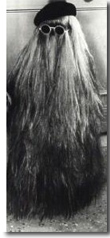 Early this week when I took the morning’s first look in the mirror I determined to get a hair cut no matter what the consequences. The hair had long since grown past its original design and started each day dispirited and dreary, flopping about without knowing quite where to lay. I had tried parting it, wetting it down and putting gel in it. The end result would be that the next time I saw it, it would have gotten into the most astonishing configurations, none of which left a positive impression. Some time before, I had called the woman who cuts my hair and explained that I would like to come into the shop before the regular day in order to avoid possible sneezes and such, and she promptly came down with the flu, canceling the possibility. This time all went well, and the improvement to my appearance is positively uplifting. Charles, who routinely has his head very nearly snipped clean of all hair said, tongue in cheek, “Now you know how I feel when I get my hair cut”. Hah. It is amazing how the taken-for-granted parts of one’s former life can become so grand! Early this week when I took the morning’s first look in the mirror I determined to get a hair cut no matter what the consequences. The hair had long since grown past its original design and started each day dispirited and dreary, flopping about without knowing quite where to lay. I had tried parting it, wetting it down and putting gel in it. The end result would be that the next time I saw it, it would have gotten into the most astonishing configurations, none of which left a positive impression. Some time before, I had called the woman who cuts my hair and explained that I would like to come into the shop before the regular day in order to avoid possible sneezes and such, and she promptly came down with the flu, canceling the possibility. This time all went well, and the improvement to my appearance is positively uplifting. Charles, who routinely has his head very nearly snipped clean of all hair said, tongue in cheek, “Now you know how I feel when I get my hair cut”. Hah. It is amazing how the taken-for-granted parts of one’s former life can become so grand!
« Previous Page
|
 The grand sounds of spring came to Sanctuary yesterday. There were meadow larks at dawn, and chains of wild geese flying overhead all morning calling out instructions to each other as they passed. In the afternoon, the red winged blackbirds came back to claim their territories from the tree tops while the cardinals have already been very actively singing out their spaces for several days now. I read that birds can share trees with other species because they live at different levels, but they must let others of their kind know what is theirs, hence all that marvelous song.
The grand sounds of spring came to Sanctuary yesterday. There were meadow larks at dawn, and chains of wild geese flying overhead all morning calling out instructions to each other as they passed. In the afternoon, the red winged blackbirds came back to claim their territories from the tree tops while the cardinals have already been very actively singing out their spaces for several days now. I read that birds can share trees with other species because they live at different levels, but they must let others of their kind know what is theirs, hence all that marvelous song.  Today, as we cross the meadow on a walk, I am leaning heavily on Charles’ arm and we are moving very slowly. “What a life!” I say sadly. “Yes” he says firmly, “and it IS a life. . . with options, including long-range ones”. After a bit, I say, “I would suppose that they have wheel-chairs in Russia” and he immediately replies, “Of course they do. . . at the very least, those big wooden ones with the high backs.” We are both smiling as we conjure up our own mental pictures of the possibilities.
Today, as we cross the meadow on a walk, I am leaning heavily on Charles’ arm and we are moving very slowly. “What a life!” I say sadly. “Yes” he says firmly, “and it IS a life. . . with options, including long-range ones”. After a bit, I say, “I would suppose that they have wheel-chairs in Russia” and he immediately replies, “Of course they do. . . at the very least, those big wooden ones with the high backs.” We are both smiling as we conjure up our own mental pictures of the possibilities.  A Port
A Port That led me to consider the possibilities of “ports”. One can easily imagine lots of the little things discreetly placed on the body; one to house the tiny iPod, perhaps, one for a cell phone, or little fingertip cameras. Just think of the convenience!
That led me to consider the possibilities of “ports”. One can easily imagine lots of the little things discreetly placed on the body; one to house the tiny iPod, perhaps, one for a cell phone, or little fingertip cameras. Just think of the convenience!  March 1, Ash Wednesday, marked the 75th day anniversary of sitting at the table and feeling the great unease and depression as I was sending out Christmas cards. It was the beginning of my new life. This is both a long time and a short one, depending on the measure. . . not quite the “90 days in jail” which used to be the norm for punishing all kinds of misadventures in the days of my youth in Iowa, but far too long for a visit by even the most beloved relative.
March 1, Ash Wednesday, marked the 75th day anniversary of sitting at the table and feeling the great unease and depression as I was sending out Christmas cards. It was the beginning of my new life. This is both a long time and a short one, depending on the measure. . . not quite the “90 days in jail” which used to be the norm for punishing all kinds of misadventures in the days of my youth in Iowa, but far too long for a visit by even the most beloved relative.  The blood draw yesterday again indicated that the disease remains active. It has taken a while for me not to regard this weekly check as sort of a test, where surely, improvement would be shown. It is the teacher brain, I think. . . try hard, do your best, and you will do better next time. Harder even than the reality of no immune system is the life of the low hemoglobin count, where the absence of red blood cells to haul oxygen around means that one is always, always weary.
The blood draw yesterday again indicated that the disease remains active. It has taken a while for me not to regard this weekly check as sort of a test, where surely, improvement would be shown. It is the teacher brain, I think. . . try hard, do your best, and you will do better next time. Harder even than the reality of no immune system is the life of the low hemoglobin count, where the absence of red blood cells to haul oxygen around means that one is always, always weary.  Yesterday an appointment was set up at the Med Center in Omaha where an acknowledged leader in MDS treatment practices. It is quite fine to be so near such a center, and we will begin next week on this part of the adventure. The nurse calling me asked me if I had any siblings should the possibility of a bone marrow transplant arise, and I said yes, two, one has disabling rheumatoid arthritis, and the other appears to enjoy good health. She said, “How old is the healthy one?” “He is seventy” I replied, and mentally added “happily living his life and minding his own business unaware of the future’s possibilities.”
Yesterday an appointment was set up at the Med Center in Omaha where an acknowledged leader in MDS treatment practices. It is quite fine to be so near such a center, and we will begin next week on this part of the adventure. The nurse calling me asked me if I had any siblings should the possibility of a bone marrow transplant arise, and I said yes, two, one has disabling rheumatoid arthritis, and the other appears to enjoy good health. She said, “How old is the healthy one?” “He is seventy” I replied, and mentally added “happily living his life and minding his own business unaware of the future’s possibilities.” Early this week when I took the morning’s first look in the mirror I determined to get a hair cut no matter what the consequences. The hair had long since grown past its original design and started each day dispirited and dreary, flopping about without knowing quite where to lay. I had tried parting it, wetting it down and putting gel in it. The end result would be that the next time I saw it, it would have gotten into the most astonishing configurations, none of which left a positive impression. Some time before, I had called the woman who cuts my hair and explained that I would like to come into the shop before the regular day in order to avoid possible sneezes and such, and she promptly came down with the flu, canceling the possibility. This time all went well, and the improvement to my appearance is positively uplifting. Charles, who routinely has his head very nearly snipped clean of all hair said, tongue in cheek, “Now you know how I feel when I get my hair cut”. Hah. It is amazing how the taken-for-granted parts of one’s former life can become so grand!
Early this week when I took the morning’s first look in the mirror I determined to get a hair cut no matter what the consequences. The hair had long since grown past its original design and started each day dispirited and dreary, flopping about without knowing quite where to lay. I had tried parting it, wetting it down and putting gel in it. The end result would be that the next time I saw it, it would have gotten into the most astonishing configurations, none of which left a positive impression. Some time before, I had called the woman who cuts my hair and explained that I would like to come into the shop before the regular day in order to avoid possible sneezes and such, and she promptly came down with the flu, canceling the possibility. This time all went well, and the improvement to my appearance is positively uplifting. Charles, who routinely has his head very nearly snipped clean of all hair said, tongue in cheek, “Now you know how I feel when I get my hair cut”. Hah. It is amazing how the taken-for-granted parts of one’s former life can become so grand!